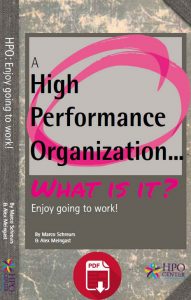Business process improvement, process simplification and process alignment
Business process improvement is defined as ‘the act of making internal business operations better.’ Business process simplification is defined as ‘the act of making internal business operations easier.’ Business process alignment is defined as ‘the act of bringing internal business operations in line with each other.’ People in an HPO are continuously looking for ways to improve and simplify all the organization’s processes, to improve the organization’s ability to respond to events efficiently and effectively. They eliminate unnecessary procedures, work, and all forms of excess and waste, and standardize the remaining work. They fight information overload, use just-intime processes, and right-size and re engineer processes to improve speed. They align all the processes seamlessly and without bottlenecks and hick-ups. They achieve continuous business process optimalization by connecting the entire value chain and applying value chain efficiency models. They do this by applying a strong systems perspective, thinking lean about every aspect of work, and becoming adept at rapidly designing and installing new ways of working.
Download chapter 1 and 2 of What Makes a High Performance Organization for free (PDF)
Or buy at Amazon (Kindle or Paperback)
Download the eBook ‘An HPO… what is it?’!
Every person in the bank feels a responsibility to improve a business process. So if we have a person in our payment department who can see that there is something wrong in the way we make crossborder payments, then he or she feels a responsibility to bring that up. We encourage people to make decisions so they are more prone to start improving. By encouraging people and even say that it can be justified to make a wrong decision as long as you learn from it, then you actually increase the likeliness that they will work to improve the processes without fear of failure.
IDEAS TO GET STARTED WITH IMPROVING YOUR BUSINESS PROCESS
Studying the data in the HPO database reveals that for organizations worldwide the average scores for business process improvement,  business process simplification and process alignment are 7.0, 5.6 and 4.8 respectively (on a scale of 1 to 10). This can be explained by the fact that organizations generally have no shortage of ideas and often energetically take up many improvement ideas – starting up business process improvement is therefore not the problem. It is a complete different matter when we look at whether the business process improvements have actually been followed through, and if so, did these result in simpler and more aligned processes. The data indicated that this is often not the case. People are good at starting but not so good at finishing business process improvements. This is what
business process simplification and process alignment are 7.0, 5.6 and 4.8 respectively (on a scale of 1 to 10). This can be explained by the fact that organizations generally have no shortage of ideas and often energetically take up many improvement ideas – starting up business process improvement is therefore not the problem. It is a complete different matter when we look at whether the business process improvements have actually been followed through, and if so, did these result in simpler and more aligned processes. The data indicated that this is often not the case. People are good at starting but not so good at finishing business process improvements. This is what
you can do to make business process improvement work:
- Focus, focus, focus! Select a limited number of improvement initiatives for implementation and make clear how important these are in relation to the day-to-day business.
- Make sure that nobody can start an improvement initiative without first submitting a plan with clear accountability setting, due dates and deliverables.
- Only start something new when the previous, agreed-upon improvement initiatives have been finalized, within time and budget.
- Conduct continuous discussions in the organization about the improvement initiatives, so everybody knows they are important and at the same time knows the status of the initiatives.
- Hire a dedicated person, a chief improvement officer, who is in charge of systematic development and improvement of all processes.
- Introduce quality assurance procedures for the improvement initiatives and make these topics of regular discussion.
- Implement a planning tool to keep track of the improvement initiatives.
- Make sure improvement initiatives are not seen as flavor of the month which, if they don´t get executed properly, will not yield consequences. Business process improvement is serious business!
At Microsoft we embrace continuous improvement. It is our mission to help organizations to improve their processes, therefore we also need to have a strong focus on this ourselves. But, most of the time, process optimization is in fact for most people a dissatisfier. Every process that supports the organization to achieve good results is often perceived as a neutral fact in the organization, while if a process is not delivering it is immediately considered a negative factor. Therefore the basis for continuous improvement in an organization is in the reason why you do things. I strongly believe that if people know what the company stands for, why we do what we do, improvements will follow naturally. You have to load it, so people get positive vibes from it. As long as you approach continuous improvement as a process to resolve negativity, for example when you need to improve in order to decrease costs or
gain productivity, it is not something that will inspire people. If you take the lead from an inspirational goal and it is clear to people what your unique vision entails, you provide the context to improve. I never get tired explaining what we stand for and how continuous improvement supports that.
We realized early on that all processes have to work well together to get a successful flight. The passengers generally only notice a safe and on-time flight. But everything before and after the flight, such as planning of the flight schedule, sales of tickets, check-in, crew planning, maintenance, are connected and have to merge seamlessly to result in this good flight. So we have process managers who are in charge of a certain process. For instance, the process manager for the process of the timetable and flight schedule gets all disciplines involved sitting around one table to jointly make the decisions to get an optimal timetable. No one discipline is more important than the others at this table, we are all in it together to achieve the best possible outcome. People come prepared to these meetings, with figures and business cases so they can have discussions in an evidence-based manner. The meetings take place every two weeks so people from different disciplines see each other regularly and can keep communicating.




